Siemens have yet to release this in most of the world. If you’re interested in the combo, drop us a quick note to
Siemens.Skype(at)Digital-Lifestyles.info. We’d be happy to pass them on to Siemens, with the vague possibility that it might hasten their introduction in your country. |
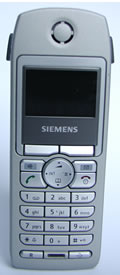
We all know that Skype is great. There’s a real thrill in speaking to people all over the world and knowing its not costing you anything at all.
The downside has been that you have to be around your computer when you’re speaking.
No more. The Siemens Gigaset M34 USB adaptor and one of a range of their handsets give you the freedom to walk around while chatting.
We’re testing the M34 with the Siemens Gigaset S440 wireless DECT handset that we first heard about back in November last year.
Here’s a sneak preview – we’re really impressed (may be even gushing) and think it marks a significant shift for the widespread acceptance of Skype.
First impressions
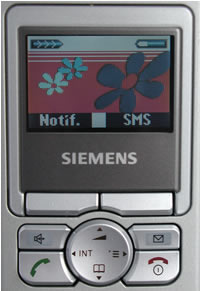 The Gigaset S440 is a handset fashioned more like a mobile phone. With a backlight colour screen and icons, it’s about the swankiest DECT handset we’ve seen. At 14cm (5.5-inches) tall, it sits comfortably in the hand.
The Gigaset S440 is a handset fashioned more like a mobile phone. With a backlight colour screen and icons, it’s about the swankiest DECT handset we’ve seen. At 14cm (5.5-inches) tall, it sits comfortably in the hand.
The S440 is available as a ‘normal’ landline phone. It’s when it’s combined with the M34 USB add-on, that it starts to become extra special.
The M34 has a slightly rounded and swoopy look to it. It’s total length is about 10cm (4-inches), under 3.5cm (1.25-inch) at it’s widest point and a little over 1cm (0.5-inch) thick. There’s a thin strip of illumination at its end.
Handset performance
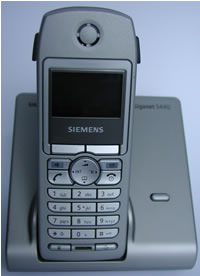 As mentioned, the Gigaset S440 is also a ‘normal’ phone and it retains this skill, giving you the ability to make both Skype and landline calls depending on your needs. Landline calls involve dialling as you would normally, and Skype takes a few steps more, which are detailed below.
As mentioned, the Gigaset S440 is also a ‘normal’ phone and it retains this skill, giving you the ability to make both Skype and landline calls depending on your needs. Landline calls involve dialling as you would normally, and Skype takes a few steps more, which are detailed below.
Not only does the S440 handset look pretty sleek, but it’s performance matches its looks. We were hugely impressed with the wireless range. The Digital Lifestyles offices are on the second floor and were able to walk down into the cellar of our building and walk down the road and around the corner and still speak via Skype or landline. It’s worth bearing in mind that we’re in the centre of London too, and the airwaves are pretty congested.
It’s a strange feeling standing in the local sandwich shop queue and receiving a Skype call. It also feels a little naughty.
Process of making a Skype call
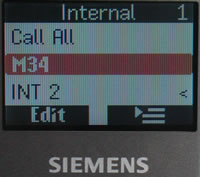 Enough of this background. How easy is it to use with Skype, I hear you call. Pretty simple.
Enough of this background. How easy is it to use with Skype, I hear you call. Pretty simple.
The summary is – once you’ve got it configured (more later), you press a few buttons, make a menu selection or two, and then you’re chatting.
Here’s the detail. At the centre of the handset is a four-way selector. You use this, to select INT, which brings up a list of other handsets and services that you can connect to. By selecting the M34 USB adaptor, you’re offered a menu of applications that you can run through the M34 (we’ll detail the others below).
Simply selecting Skype, brings up the your Skype buddy list on the handset. How cool is that?
To speak to any of them, simply highlight the name, press the Green dial button and you’re speaking on a normal phone handset – via Skype!
Using the handset daily
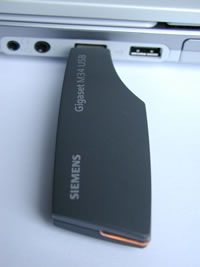 We found it becomes completely natural to use the S440/M34 combo. You really notice how restricted you are when you’ve got to call without it.
We found it becomes completely natural to use the S440/M34 combo. You really notice how restricted you are when you’ve got to call without it.
When the pure thrill of Skyping on a handset wears off, we found ourselves wishing that switching between using the M34 for landline calls and Skype was a little quicker – just because we’re impatient. Don’t forget, this is an initial release and the handset wasn’t designed from the outset to make Skype calls. We’d imagine later generations will have a single key to take you to the list of your Skype buddies.
If you need to make calls to International landlines, you’re in luck, as SkypeOut is catered for too. When the handset is in Skype mode, simply dial the full international number and you’ll connect. Just like dialling from a mobile phone – but at Skype’s reduced prices.
So what happens when your yabbering away on a Skype call and you receive a legacy (landline) call? The S440 bleeps in your ear and you’re offered the option to disconnect from Skype. You can then take the call as normal.
Receiving a Skype call is as simple accepting a connection.
If you’re using the phone all day, and believe us when the calls are totally free, you’ll be chatting on it a lot. The battery lasts about a day, so you’ll need to recharge overnight.
Setting it up with Skype
 The set-up needs to be done in the right order, but if you follow the instructions it will work without a problem.
The set-up needs to be done in the right order, but if you follow the instructions it will work without a problem.
Assuming you already have Skype running on your PC, install the M34 driver disk and plug the M34 in to an available USB port. After running the Gigaset M34 software and syncing the S440 base station with the M34, you’re away – with your Skype buddies appearing on your handset.
Beyond setting it up to run with Skype, the application that comes with the M34 lets you program the dialling memories of the handset, but from the comfort of your own PC keyboard. It can also integrate with MS Outlook.
It does more than Skype
And you thought Skyping was enough?
We imagine you’re pretty impressed with the ability to Skype on this handset, but there’s a world of extra features available too.
Here’s a brief run down.
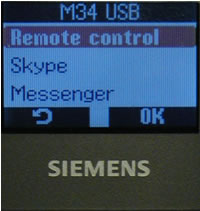 Instant Messenger via Skype, AOL or MSN. We tried this, but didn’t make a habit of it. It’s okay for very brief messages, but the restriction of the keyboard makes you itch to get back on the QWERTY.
Instant Messenger via Skype, AOL or MSN. We tried this, but didn’t make a habit of it. It’s okay for very brief messages, but the restriction of the keyboard makes you itch to get back on the QWERTY.
Remotely trigger applications on your PC from the DECT handset. We couldn’t actually think of any practical uses for this, but you might get excited about the idea triggering a CD compilation while you’re sitting in the garden.
SMS from your landline. This has been done by a couple of other handsets, and more likely to be used by people who don’t already own a mobile phone.
Conclusion
You should be able to tell, we’re impressed with the Gigaset M34/S440 DECT handset combo.
In our eyes it’s a Product Of Significance, as we had thought when we first heard about it.
It takes Skype out of the hands of the technically aware, directly into the hands of every consumer. There can be no-one in the developed world who doesn’t know how to use a phone handset. If you can do that, you can now use Skype.
No longer do you need to be tied to a computer to use Skype. You can wander free, while smiling to yourself that you’re not spending a penny, to speak to someone on the other side of the world.
We’re aware there are other Skype handsets around, but from what we’ve seen, none of them are as integrated as this Siemens solution.
Sure, to get this product to perfection it could do with single key to get you to your Skype buddy list, and the battery could last a little longer, but this is the first release.
While the M34 & S440 aren’t quite perfect … we’d recommend them to anyone.
 As the number of digital TV-enabled households continues to rise and the analogue switch off looms ever closer, it seems strange that Sony’s RDR-GXD500 is the first DVD recorder to come equipped with a built-in digital TV tuner.
As the number of digital TV-enabled households continues to rise and the analogue switch off looms ever closer, it seems strange that Sony’s RDR-GXD500 is the first DVD recorder to come equipped with a built-in digital TV tuner.  The unit’s onscreen interface is simplicity itself, with the eight-day electronic programme guide (EPG) banishing those video timer nightmares forever – this puppy is so simple, even a granny overdosed on Christmas sherry would have no problem setting up a recording of Des and Mel.
The unit’s onscreen interface is simplicity itself, with the eight-day electronic programme guide (EPG) banishing those video timer nightmares forever – this puppy is so simple, even a granny overdosed on Christmas sherry would have no problem setting up a recording of Des and Mel. 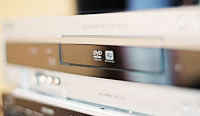 A range of recording quality modes let you increase recording time at the expense of image quality.
A range of recording quality modes let you increase recording time at the expense of image quality. 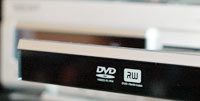 Highly recommended
Highly recommended ![]()
![]()
 Samsung have made their intentions clear. They want to be the number one in portable music players.
Samsung have made their intentions clear. They want to be the number one in portable music players. 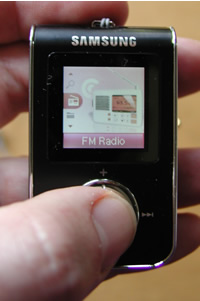 The potential of the 65k colour screen is well demonstrated by the graphically-rich menuing, but when you try to display photos and text files on it, its limitations are highlighted – it’s just too small, and when loading images, slow.
The potential of the 65k colour screen is well demonstrated by the graphically-rich menuing, but when you try to display photos and text files on it, its limitations are highlighted – it’s just too small, and when loading images, slow. 
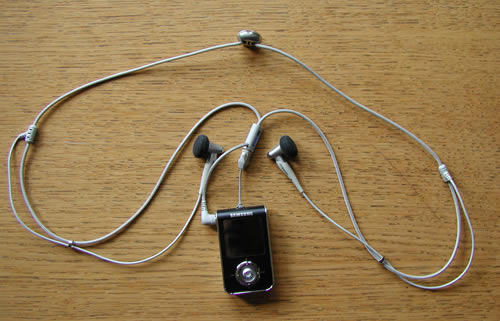


 Introduction
Introduction

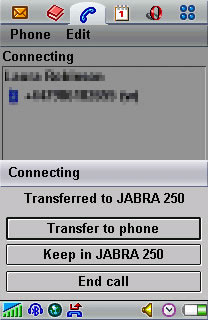 After some time, it is possible to become accustomed to the buttons, but nevertheless, technology should be intuitive, not require training. On the Logitech, this button is on the outside of the unit, and is easily accessible. Of course, pressing a button isn’t the only way to answer a call: It is also possible to simply say “answer”, if your phone supports this function, and this is one place where the Jabra is better than the Logitech: With the Logitech, the word answer has to be said quite loud, whereas with the Jabra, it can be muttered and the headset still recognises it. This is a big advantage as you, like me, will probably not want to stand there yelling “ANSWER!” at the top of your voice. It would just make you look stupid!
After some time, it is possible to become accustomed to the buttons, but nevertheless, technology should be intuitive, not require training. On the Logitech, this button is on the outside of the unit, and is easily accessible. Of course, pressing a button isn’t the only way to answer a call: It is also possible to simply say “answer”, if your phone supports this function, and this is one place where the Jabra is better than the Logitech: With the Logitech, the word answer has to be said quite loud, whereas with the Jabra, it can be muttered and the headset still recognises it. This is a big advantage as you, like me, will probably not want to stand there yelling “ANSWER!” at the top of your voice. It would just make you look stupid! 
 PalmOne’s Tungsten E – introduced in 2004 – proved to be a rip-roaring success, becoming the top-selling handheld in North America and among one of the best sellers world-wide.
PalmOne’s Tungsten E – introduced in 2004 – proved to be a rip-roaring success, becoming the top-selling handheld in North America and among one of the best sellers world-wide.  Apart from the inclusion of palmOne’s new Multi-Connector serial port (replacing the previous mini-USB port), everything is much the same as its predecessor, with the directional pad, application buttons, SDIO slot, IR port, headphone jack and metal barrel stylus being unchanged.
Apart from the inclusion of palmOne’s new Multi-Connector serial port (replacing the previous mini-USB port), everything is much the same as its predecessor, with the directional pad, application buttons, SDIO slot, IR port, headphone jack and metal barrel stylus being unchanged. 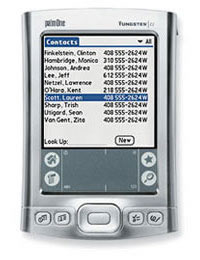 Other software includes a media suite (for playing back videos or viewing photo stills) an upgraded PIM suite, Web browser in ROM, with VersaMail and Documents To Go available on the included CD.
Other software includes a media suite (for playing back videos or viewing photo stills) an upgraded PIM suite, Web browser in ROM, with VersaMail and Documents To Go available on the included CD. 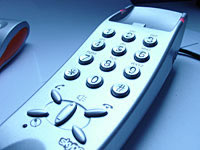 Skype is a Voice over IP (VoIP) service that allows you to make phone calls via a broadband connection to other users for free. And we like it.
Skype is a Voice over IP (VoIP) service that allows you to make phone calls via a broadband connection to other users for free. And we like it.  Despite all the benefits of VoIP telephony, the perceived ‘fiddlyness’ of the technology makes it look like an uber-geeky toy for weird, gadget-loving, parameter tweaking folks (cough!).
Despite all the benefits of VoIP telephony, the perceived ‘fiddlyness’ of the technology makes it look like an uber-geeky toy for weird, gadget-loving, parameter tweaking folks (cough!). 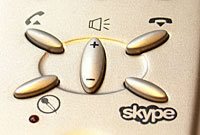 Once installed, picking up the Cyberphone causes the Skype interface to immediately pop up on your PC’s desktop (sadly, this amused us for some time) and you can then scroll through your contacts via the ‘+’ and ‘-‘ buttons on the phone’s keypad.
Once installed, picking up the Cyberphone causes the Skype interface to immediately pop up on your PC’s desktop (sadly, this amused us for some time) and you can then scroll through your contacts via the ‘+’ and ‘-‘ buttons on the phone’s keypad. 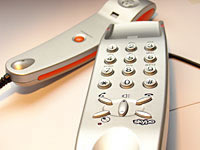 Naturally, fellow Skype users can ring you for free too, and you can elect to use your PC’s ring tones or use the one built into the phone.
Naturally, fellow Skype users can ring you for free too, and you can elect to use your PC’s ring tones or use the one built into the phone. 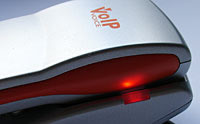 VERDICT
VERDICT 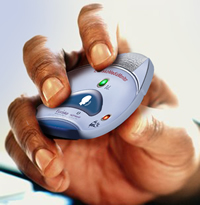 Arbitron Portable People Meter and Eurisko Media Monitor selected for further field testing
Arbitron Portable People Meter and Eurisko Media Monitor selected for further field testing  To make the test as thorough as possible, hundreds of unique listening environments were generated, with RAJAR specifying several criteria which the audiometers should fulfil – these included the ability to identify all formats equally, whether music or speech, against a variety of extraneous background noises, when played at differing volume levels and regardless of whether the wearers were stationary or in motion.
To make the test as thorough as possible, hundreds of unique listening environments were generated, with RAJAR specifying several criteria which the audiometers should fulfil – these included the ability to identify all formats equally, whether music or speech, against a variety of extraneous background noises, when played at differing volume levels and regardless of whether the wearers were stationary or in motion.  We all know that Skype is great. There’s a real thrill in speaking to people all over the world and knowing its not costing you anything at all.
We all know that Skype is great. There’s a real thrill in speaking to people all over the world and knowing its not costing you anything at all.
 The Gigaset S440 is a handset fashioned more like a mobile phone. With a backlight colour screen and icons, it’s about the swankiest DECT handset we’ve seen. At 14cm (5.5-inches) tall, it sits comfortably in the hand.
The Gigaset S440 is a handset fashioned more like a mobile phone. With a backlight colour screen and icons, it’s about the swankiest DECT handset we’ve seen. At 14cm (5.5-inches) tall, it sits comfortably in the hand.  As mentioned, the Gigaset S440 is also a ‘normal’ phone and it retains this skill, giving you the ability to make both Skype and landline calls depending on your needs. Landline calls involve dialling as you would normally, and Skype takes a few steps more, which are detailed below.
As mentioned, the Gigaset S440 is also a ‘normal’ phone and it retains this skill, giving you the ability to make both Skype and landline calls depending on your needs. Landline calls involve dialling as you would normally, and Skype takes a few steps more, which are detailed below.  Enough of this background. How easy is it to use with Skype, I hear you call. Pretty simple.
Enough of this background. How easy is it to use with Skype, I hear you call. Pretty simple.  We found it becomes completely natural to use the S440/M34 combo. You really notice how restricted you are when you’ve got to call without it.
We found it becomes completely natural to use the S440/M34 combo. You really notice how restricted you are when you’ve got to call without it.  The set-up needs to be done in the right order, but if you follow the instructions it will work without a problem.
The set-up needs to be done in the right order, but if you follow the instructions it will work without a problem.  Instant Messenger via Skype, AOL or MSN. We tried this, but didn’t make a habit of it. It’s okay for very brief messages, but the restriction of the keyboard makes you itch to get back on the QWERTY.
Instant Messenger via Skype, AOL or MSN. We tried this, but didn’t make a habit of it. It’s okay for very brief messages, but the restriction of the keyboard makes you itch to get back on the QWERTY.  With all the competition from the "red button" and "iPod favourites" radio needs an electronic programme guide – an EPG. At IBC, Unique Interactive together with two receiver manufacturers –
With all the competition from the "red button" and "iPod favourites" radio needs an electronic programme guide – an EPG. At IBC, Unique Interactive together with two receiver manufacturers – 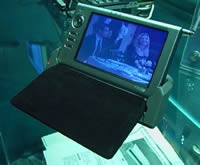 They know the broadcast network is ideally suited to mass distribution of media rich content. The economics of sending 3 minutes of video to 100,000 people make 3G a very expensive way of getting content broadcast, especially in a crisis. Nokia know that, but have chosen partners such as NTL and HP to work on a competing method of content distribution, DVB-H. Both are really in the physics experiment stage – no-one has developed stimulating content for these platforms yet – and it is not going to be ringtones that save the day
They know the broadcast network is ideally suited to mass distribution of media rich content. The economics of sending 3 minutes of video to 100,000 people make 3G a very expensive way of getting content broadcast, especially in a crisis. Nokia know that, but have chosen partners such as NTL and HP to work on a competing method of content distribution, DVB-H. Both are really in the physics experiment stage – no-one has developed stimulating content for these platforms yet – and it is not going to be ringtones that save the day  Philips has a system called Streamium, which is more of a Wi-Fi enabled hi-fi/boombox. A clever piece of kit, but Philips haven’t a clue on how to promote it to the public. A Cambridge based research company called
Philips has a system called Streamium, which is more of a Wi-Fi enabled hi-fi/boombox. A clever piece of kit, but Philips haven’t a clue on how to promote it to the public. A Cambridge based research company called  Sony HD-CAM, the HDR-FX1, which will offer entry-level hi-definition video for the prosumer market for around €3,500 (~$4,314, ~£2,390). It also seems crazy that many of the best video editors can be downloaded for a couple of hundred bucks for personal use and yet some audio editors have made it impossible for the freelance community to buy cheap personal copies of the software. They forget what power of persuasion these people have in getting technology adopted within many broadcasting stations.
Sony HD-CAM, the HDR-FX1, which will offer entry-level hi-definition video for the prosumer market for around €3,500 (~$4,314, ~£2,390). It also seems crazy that many of the best video editors can be downloaded for a couple of hundred bucks for personal use and yet some audio editors have made it impossible for the freelance community to buy cheap personal copies of the software. They forget what power of persuasion these people have in getting technology adopted within many broadcasting stations.